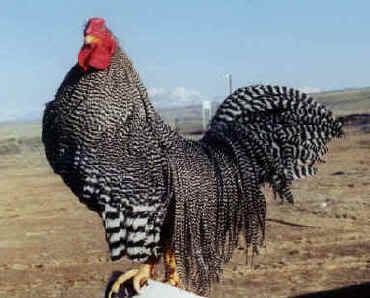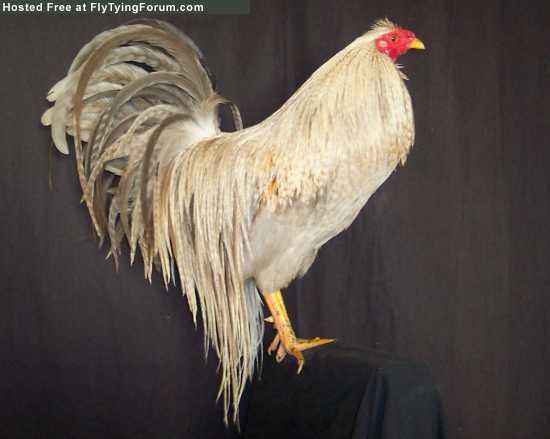Being a `pond lies at the bottom of it' and not a `river runs through it' sort of fisherman, I was unaware that there are 10,000 roos crowing together every morning, out in Colorado, for fly fishers.
While rooting around for chicken/turkey genome info. I came across this handsome fellow on the Mich.State Univ. Poultry Genome page:

And another shot from the journal Nature:

(both photos by Tom Whiting)
I wanted one. But, now I know that the closest I'll get is a hackle in a tackle shop. The first link below is a short interview with Henry Hoffman (started with a five dollar breeding pair of `Grizzly' Bantams). Many years later he `passed on' his stock to Dr. Tom Whiting. The Whiting interview (2cnd link) is extensive (with observations of the roo farm by the interviewer) and, though Whiting focuses on breeding for hackles, the information could be of use to anyone breeding for any specific trait. Sebright would probably be doing something along these lines if he was still alive.
http://www.westfly.com/feature/oldfeatures/feature_30.htm
http://www.uncleginkscave.com/GC-WhitingHackleFarms.html
enjoy! (does anyone else have these?)
While rooting around for chicken/turkey genome info. I came across this handsome fellow on the Mich.State Univ. Poultry Genome page:

And another shot from the journal Nature:

(both photos by Tom Whiting)
I wanted one. But, now I know that the closest I'll get is a hackle in a tackle shop. The first link below is a short interview with Henry Hoffman (started with a five dollar breeding pair of `Grizzly' Bantams). Many years later he `passed on' his stock to Dr. Tom Whiting. The Whiting interview (2cnd link) is extensive (with observations of the roo farm by the interviewer) and, though Whiting focuses on breeding for hackles, the information could be of use to anyone breeding for any specific trait. Sebright would probably be doing something along these lines if he was still alive.
http://www.westfly.com/feature/oldfeatures/feature_30.htm
http://www.uncleginkscave.com/GC-WhitingHackleFarms.html
enjoy! (does anyone else have these?)




